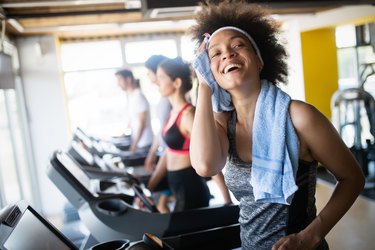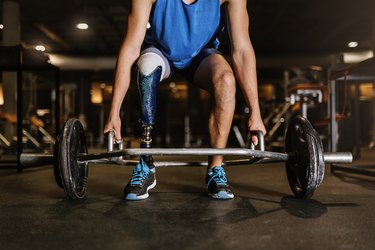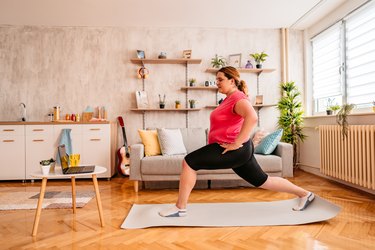
Establishing — and sticking to — a regular exercise routine always takes effort. But working out may present unique challenges for people with larger bodies.
For starters, there are workout clothes. While many activewear brands are putting in the effort to expand their size offerings, many still leave plus-size folks struggling to find workout gear they feel supported in.
Video of the Day
Video of the Day
In other cases, people with larger bodies may feel intimidated by or out of place in traditional gym settings, or exercise may be physically uncomfortable or painful.
But it's not all bad news. We tapped two trainers for their top tips for breaking down these and other barriers to make exercise a better, more comfortable experience for all.
First, a Note on the Term 'Plus-Size'
We make deliberate choices about the language we use when it comes to body size. We recognize that different people use different language to describe their own body size — some identify as "fat" while others prefer "plus-size," for example. We've mainly used "plus-size" throughout this article because that's how our sources identify.
1. Connect With Your 'Why'
Knowing your reason for working out may help you stick with it for the long haul, especially when the going gets tough.
Many people assume that all plus-size athletes are exercising to lose weight. While there's nothing wrong with wanting to lose weight if that's your goal, exercise offers many other benefits. And some of them can be seen much faster than aesthetic goals like weight loss.
"Within two weeks of starting classes, most of my clients are sleeping better, they have more energy, their sex life is better, so it's not just about weight loss," says Sarah Taylor, CPT, a plus-size personal trainer, model, motivational speaker and virtual fitness studio owner.
Exercise is also a great way to build strength, muscle and overall fitness. You might strive to deadlift the equivalent of your body weight (or more!), compete in an endurance event or move better on a daily basis. Identify what you'd like to achieve through exercise and remember: Weight loss isn't the only option.
Related Reading
2. Ask for Help
If you're intimidated by the thought of entering a new gym — a common issue for many athletes of any size — embracing your discomfort may actually help you get through the door. Adopt the mindset that you're headed into unfamiliar territory and you'll need help navigating the space.
"That could mean going into an actual gym and asking somebody at the front desk to give you a tour, or possibly even getting a session with a trainer just so you know what to do, especially if you're new to exercise," Taylor says.
And if you're not sure how to do an exercise or use the machines once your workout is underway, ask a personal trainer or somebody at the front desk for help. That's part of their job!
Working out with a friend who's more experienced in the exercise department may also help you learn the ropes.
3. Invest In a Great Sports Bra
For plus-size athletes with breasts, a supportive, comfortable sports bra is a must. After all, a July 2020 article in Exercise and Sport Sciences Reviews — not to mention real-world experience — notes a poorly fitted sports bra can cause significant discomfort and pain during exercise. And most of us don't want to work out when we're uncomfortable or in pain.
On the other hand, a great-fitting sports bra will make your breasts feel secure without any fabric digging into or chafing your skin. Styles vary, but wide, adjustable straps generally offer greater support than spaghetti-thin straps.
Get your chest measured to ensure you find the correct bra size. Most intimates stores offer bra fitting services, but as Taylor points out, it can be tough to find the right size in-store, especially if you're plus-size.
Thankfully, many online bra vendors have stepped up their fitting game, making it easier to find the right fit from home. Keep in mind you may need to break out the measuring tape and take some measurements on your own.
Taylor recommends sports bra company SheFit. They offer virtual bra fitting services, as well as text, phone and email fit support. If you prefer to do it yourself, take their fit quiz and compare your measurements to their size charts.
Shop These Sports Bras We Love
4. Find Workout Clothes You Love
Once upon a time, the only workout clothing option available to athletes with larger bodies was a baggy T-shirt and sweatpants. That's fine if that's what feels most comfortable for you, but there are so many other styles to try. These days, more and more activewear companies are offering a wider range of sizes and styles geared toward the plus-size buyer.
A few of Taylor's top brand recommendations for plus-size workout clothes include GRRRL Clothing (they don't use sizes; instead, they list the measurements of their models so you can compare), Old Navy (sizes XS to 3XL regular; M to 3XL tall) and Superfit Hero (sizes L to 7XL). Nike, Under Armour and Reebok are a few other activewear brands that offer a wider range of sizes.
Look for workout clothes that make you feel comfortable and confident. "I work out in a crop top and teach in a crop top or a sports bra to help other women normalize seeing their plus-size body," Taylor says.
Also, play around with colors and patterns. "You don't have to wear black," Taylor says.
That said, some styles tend to be more plus-size-friendly than others. For one: "High-waisted leggings are my absolute favorite — this way, they stay up!" says Morit Summers, CPT, founder of FORM Fitness Brooklyn and author of Big & Bold: Strength Training for the Plus-Size Woman.
Just check that the leggings are squat-proof (read: You can't see through them when you bend over), don't fall down and are easy to move around in before buying. "Those are the kinds of things you can test in a changing room," Taylor says.
5. Prevent Skin Chafing
Chafing affects every athlete, regardless of body size. However, carrying more weight may make your skin more likely to rub together in certain areas.
To prevent dreaded skin chafe, look for workout gear made of moisture-wicking fabrics, such as polyester, nylon or polypropylene. Opt for workout tops and bottoms that cover friction hot-spots, such as your armpits and inner thighs. For example, Summers typically buys shorts that are just long enough to have fabric between her thighs, she says. This prevents the skin from rubbing together and, in the process, prevents chafing.
It's also important to avoid oversized clothes. When excess fabric bunches up and mixes with sweat, it can rub against your skin and cause irritation. Clothes with flat seams can also prevent chafing.
For added insurance, glide some anti-chafing balm or cream anywhere you tend to chafe during exercise and daily activity.
6. Modify Exercises as Needed
Every body is different. That means specific exercises may feel more comfortable for some bodies and not others. But instead of forcing yourself to move through an exercise you find awkward or uncomfortable, modify it so it works with, not against, your body.
To get you started, Summers and Taylor offer tips to make common strength moves more accessible. However, keep in mind that these are only suggestions. Test them out and tweak until the exercise works for your individual body.
- Deadlifts: Create more room for your stomach and/or breasts by stepping your feet just wider than shoulder-width apart or even farther to do a sumo deadlift.
- Squats: Widen your stance and don't squat as low. Work toward greater depth by squatting until your butt touches a study chair, bench or box. Or, if you have access to a suspension trainer like a TRX, hold onto the handles for support while you squat.
- Lunges: If lunges cause knee and/or ankle pain, try swapping them out for step-ups on a box or step to build single-leg strength and balance. Once you feel strong enough to attempt lunges again, hold onto a wall, countertop, broomstick or other object for support while you lunge. From there, add depth or weight to make lunges more challenging.
- Jumping Jacks: Jumping jacks can be done as a step-out with both arms raised overhead.
- Push-Ups and Planks: Test push-up variations and plank variations that eliminate some of the stress on your body and increase your range of motion. The easiest option is to perform the exercises with your hands on a wall or countertop.
- Core Exercises: Almost any core exercise can be done from a standing position. For example, instead of doing the bird-dog exercise on the floor, stand while you lift one arm and opposite leg. Squeeze your glutes and switch sides. You can lean your torso forward until it's parallel (or almost parallel) to the floor, or support your non-working arm on a wall or chair for balance.
7. Find Alternatives to Exercise Machines
Exercise machines — particularly strength machines — are not one-size-fits-all. And some machines can be especially uncomfortable for plus-size folks.
The leg press, for example, is often an intimidating machine for people with larger stomachs. "Bringing your legs down that far can be tricky — your belly gets in the way," Taylor says. If you experience this issue with the leg press machine, you may want to stick with squats.
Then, there are some machines that don't fit. Literally. Summers points to the leg extension machine as one example: "The top piece only opens so far, and if your thighs are large, you may not be able to get in."
Similarly, the handles on the sides of the assisted pull-up machine are often very narrow, and some people may not be able to fit. "My hips touch [the handles] when I go up and down with this machine," Summers says.
As with body-weight and free-weight exercises, it's important to find alternatives that work for you. So, if you can't fit into the leg extension machine, you might try body-weight leg extensions while standing or sitting in a chair. And if the assisted pull-up machine is a no-go, work your pull-up muscles with inverted rows.



